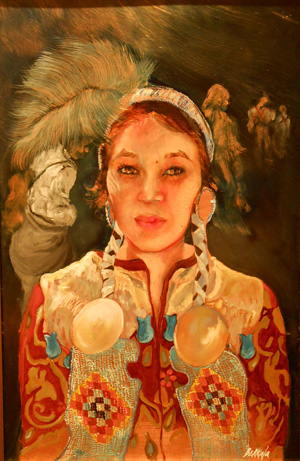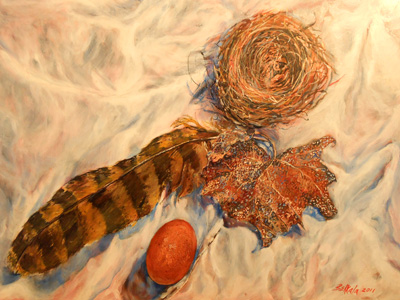The Luminescent Glow of Painting on Copper
 Elsa Bekkala Painting on copper.
Elsa Bekkala Painting on copper. Photograph courtesy of Elsa Bekkala.
Artist Elsa Bekkala was born in the copper countryside of Keweenaw Bay, Michigan, to apple and dairy farmers of Finnish-Saami descent. In Michigan’s Upper Peninsula, the nearby copper mines were of vital importance to the local economy, and Bekkala has very fond memories of copper from an early age.
“To a child, the warm color of copper made it appear more valuable than silver or gold,” she says. “Try experimenting with a child who has not yet learned the value of money. If offered a handful of various coins, a child will often choose a penny, because of its inherent beauty."
Her parents were attuned to nature and her older sister started her sketching on the farm. “She has been quite protective and a large presence all of my life,” says Bekkala. “I was able to observe my environment as it unfolded around us.”
When the family farm failed, the move to Detroit deepened Bekkala’s creative and philosophical nature. It was there her love for painting really manifested itself. She was greatly inspired by a 4th grade class trip to the Detroit Institute of Arts and went on to scour libraries and museums in the city.
She was motivated by some very creative art teachers in high school. After graduating, she became employed at an art supply store to pay for classes at the Center for Creative Studies. Working on assembly lines later convinced her she wanted to do one-of-a-kind artwork that portrayed her surroundings. She put herself through a Master of Fine Arts Degree at Rhode Island School of Design and a doctoral degree from Columbia University in studio/art education. She wrote a 300 page book The Development of Artists at Rhode Island School of Design.
At the libraries of both institutions, Bekkala researched and developed her painting skills step-by-step. She began drawing and advanced to watercolors, which put light into her work, before moving on to oils.
 Elsa Bekkala Painting on copper.
Elsa Bekkala Painting on copper. Photograph courtesy of Elsa Bekkala.
“I was fascinated by the early masters such as Claude Lorrain and the inner glow of his paintings,” she says. “Centuries ago, printmakers would etch directly on copper. After they made their prints, the drawings were still there so, not wanting to waste the metal, they painted over it. I duplicated their methods of preparing copper and preventing the oils from deteriorating. I also studied the American Luminist Movement. My own paintings are more on the realistic, classical side.”
Bekkala has many steps to achieve her signature look. First, she utilizes sandpaper to raise the “tooth” of the copper.
“Because it is a slick and shiny surface, this method gives the paint something to hang onto,” she reveals. “I always use transparent oils and apply a thin first layer. After that dries, I paint more layers very slowly so that the glow of the copper shines through. The smooth surface of copper makes it possible to use fine detail. The biggest dilemma is determining how much to cover. A mastic varnish finishes the piece.”
Originally, she bought 16 oz. pure copper from CBC Metal Supply Company in Brooklyn, NY. She now uses 28 gauge Copper Plus from Heyco Metals in Reading, PA.
Bekkala prefers copper to other metals because of its durability and longer lifespan.
“I have been painting on copper for more than 30 years.” she says. “In addition to its beautiful luminescence, copper is so enduring, whereas linen and canvas can tear or deteriorate over time. My paintings are my children. I want them to outlive me.”
Most paintings contain careful proportions of figures and the fine nuances found in landscapes. Her works on copper allow for various manipulations contrasting with minute detail and have the quality of icons. Once when she picked flowers and brought them inside to study their complexity, her involvement led to a 50”x50” composition that took six weeks to complete.
 Elsa Bekkala Painting on copper.
Elsa Bekkala Painting on copper. Photograph courtesy of Elsa Bekkala.
Bekkala has traveled the world with her painting. She has taught classes in the West Indies, and spent time in Spain, Rhode Island and the Great Desert Basin in Nevada. The latter, especially, engaged all her senses and allowed her to paint what she felt inside. Objects like an abandoned couch sitting in the middle of vast amounts of sand intrigued her and resulted in a painting.
In New York City, where she lived for 25 years, she painted and instructed art lessons at Columbia and Adelphi, among other schools. From September 1998 to 2011 she taught advanced painting and drawing, foundations in art, mural painting and fashion design courses at Herbert H. Lehman High School in the Bronx, NY. She has taught at numerous venues and enjoyed “fanning the spark and passing on the torch to other artists.”
Bekkala visited her sister and brother-in-law in Lafayette, KY, and stayed. “I need the time and space that the town provides. I walk the dry stream beds and corn fields. There is beautiful, rolling land everywhere. It reminds me of the Finnish-American community I grew up in. My sister lives across the street.
“I bought an old bank building there a few years ago and transformed it into a large painting studio. My work has evolved through experience with such issues as migration away from family farms, responsibility to employment of quality painting materials, plus the development and resilience of artists. Studio 1898 is walking distance from my house.”
Her collection at the studio includes Saami-inspired art such as Madonna: a portrait of a woman and child, an Indian woman from a local tribe and more. Easels displayed in the front window radiate the glow of her copper paintings to passers by.
Her art has been shown in London, England, Finland and throughout the USA in numerous exhibitions and one-person shows. Students of hers have also had their works displayed and awarded at shows and events. In October and November, 2014, a one-person exhibition containing 30 of her paintings, “People And The Land,” was shown at Janice Mason Art Museum in Cadiz, KY. She has been interviewed by National Public Radio and a local Kentucky radio program.
Bekkala has become a role model to artists around the country over the course of her career, and encourages her students to do the same.
“Artists should endeavor first to be well educated and part of the mainstream playing leadership roles,” she says. “They should not be disunited from society.”
Resources:
Also in this Issue:
- The Luminescent Glow of Painting on Copper
- David Rush: Painting Copper with Fire
- Carl Altman’s Love of Sunlight Through Stained Glass
- Mastering the Art of Flame Painting
- Yogi Berra Museum & Learning Center Unveils Champions in Bronze
